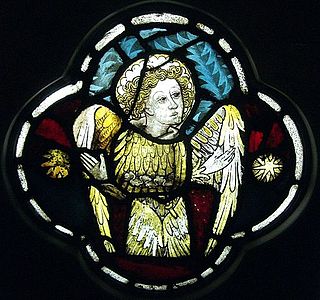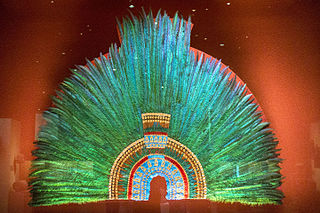 W
WFeatherwork is the working of feathers into a work of art or cultural artifact. This was especially elaborate among the peoples of Oceania and the Americas, such as the Incas and Aztecs.
 W
WThe ʻAhu ʻula, and the mahiole were symbols of the highest rank of the chiefly aliʻi class of ancient Hawaii. The feathered cloaks and capes provided physical protection, and were believed to provide spiritual protection for their wearers. There are over 160 examples of this traditional clothing in museums around the world. At least six of these cloaks were collected during the voyages of Captain Cook. These cloaks are made from a woven netting decorated with bird feathers and are examples of fine featherwork techniques. One of these cloaks was included in a painting of Cook's death by Johann Zoffany.
 W
WThe Feather Book of Dionisio Minaggio, also referred to in Italian as Il bestiario barocco, is a collection of 156 pictures made almost entirely from bird feathers augmented with pieces of bird skin, feet, and beaks. They were created between 1616 and 1618 by Dionisio Minaggio, the chief gardener of the Duchy of Milan and were originally bound into a book. The majority of pictures in the book are of birds indigenous to the Lombardy region of Italy at the time, but it also contained sets of other images depicting hunters, tradesmen, musicians, and commedia dell'arte characters.
 W
WFeather cloaks have been used by several cultures.
 W
WFeather tights is the name usually given by art historians to a form of costume seen on Late Medieval depictions of angels, which shows them as if wearing a body suit with large scale-like overlapping downward-pointing elements representing feathers, as well as having large wings. Other sources use feathered angels to describe the style. The style is assumed to derive from actual costumes worn by those playing angels in medieval religious drama, with the "feathered" elements presumably flaps or lappets of cloth or leather sewn onto a body suit. The feathers on angels in art can often to be seen to stop abruptly at the neck, wrists and ankles, sometimes with a visible hemline, reflecting these originals.
 W
WA fully feathered basket is a type of basket crafted by a select group of Indigenous people of California who have traditionally resided in the coastal region of Northern California above San Francisco. The baskets are distinguished by the matted layer of feathers, which completely cover the exterior of the basket. They are highly collectible and renowned for their fine craftsmanship.
 W
WA kāhili is a symbol of the aliʻi chiefs and families of the Hawaiian Islands. It was taken by the Kamehamehas as a Hawaiian royal standard and used by the Royal Families to indicate their lineage.
 W
WLīloa's Kāʻei (Liloa's Sash) or Kāʻei Kapu o Liloa (the sacred sash of Līloa) is the sacred feathered sash of Līloa, king of the Big Island of Hawaiʻi. The Statue of Kamehameha the Great, commissioned by King Kalākaua, displayed the kāʻei.
 W
WHawaiian feather helmets, known as mahiole in the Hawaiian language, were worn with feather cloaks. These were symbols of the highest rank reserved for the men of the aliʻi, the chiefly class of Hawaii. There are examples of this traditional headgear in museums around the world. At least sixteen of these helmets were collected during the voyages of Captain Cook. These helmets are made from a woven frame structure decorated with bird feathers and are examples of fine featherwork techniques. One of these helmets was included in a painting of Cook's death by Johann Zoffany.
 W
WMexican featherwork, also called "plumería", was an important artistic and decorative technique in the pre-Hispanic and colonial periods in what is now Mexico. Although feathers have been prized and feather works created in other parts of the world, those done by the amanteca or feather work specialists impressed Spanish conquerors, leading to a creative exchange with Europe. Featherwork pieces took on European motifs in Mexico. Feathers and feather works became prized in Europe. The "golden age" for this technique as an art form was from just before the Spanish conquest to about a century afterwards. At the beginning of the 17th century, it began a decline due to the death of the old masters, the disappearance of the birds that provide fine feathers and the depreciation of indigenous handiwork. Feather work, especially the creation of "mosaics" or "paintings" principally of religious images remained noted by Europeans until the 19th century, but by the 20th century, the little that remained had become a handcraft, despite efforts to revive it. Today, the most common feather objects are those made for traditional dance costumes, although mosaics are made in the state of Michoacán, and feather trimmed huipils are made in the state of Chiapas.
 W
WMoctezuma's headdress is a featherwork crown which tradition holds belonged to Moctezuma II, the Aztec emperor at the time of the Spanish conquest. However, its provenance is uncertain, and even its identity as a headdress has been questioned. It is made of quetzal and other feathers with sewn-on gold detailing. It is now in the Weltmuseum Wien, and is a source of dispute between Austria and Mexico, as no similar pieces remain in Mexico. Restoration efforts reignited this dispute in 2012.
 W
WNāhiʻenaʻena's Pāʻū is the largest known Hawaiian feather cloak. It is a feather skirt (pāʻū) made for Princess Nāhiʻenaʻena.
 W
WTian-tsui is a style of Chinese art featuring kingfisher feathers. For 2,000 years, the Chinese have been using the iridescent blue feathers of kingfisher birds as an inlay for fine art objects and adornment, from hairpins, headdresses, and fans to panels and screens. While Western art collectors have focused on other areas of Chinese art including porcelain, lacquer ware, sculpture, cloisonné, silk and paintings, kingfisher art is relatively unknown outside of China.
 W
WThe toupha or toufa is a kind of ornamental crest or head-dress with a plumage of the feathers, hair or bristles of exotic animals, worn in classical antiquity as a triumphal decoration. In surviving depictions, it is most often seen on military helmets and emperors' crowns.
 W
WWar bonnets are feathered headgear traditionally worn by male leaders of the American Plains Indians Nations who have earned a place of great respect in their tribe. Originally they were sometimes worn into battle, but they are now primarily used for ceremonial occasions. In the Native American and First Nations communities that traditionally have these items of regalia, they are seen as items of great spiritual and political importance, only to be worn by those who have earned the right and honour through formal recognition by their people.